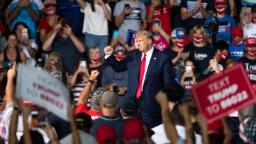
Election 2020: History shows why the next few weeks are critical for Trump

History suggests, however, that the next two-and-a-half weeks until the first debate will be a crucial period. If President Donald Trump is unable to make up at least some ground, it could be very difficult for his campaign to end up on the winning side come November.
While debates are often seen as gamechangers, it’s often the period after the conventions are in the rearview mirror and before the debates when the political environment becomes clear.
Take a look at all the election cycles since 1972. Specifically, look at where the national polling averages stood 35 days before the election (i.e. the day of the first 2020 general debate). The polls have been surprisingly predictive.
There has just been about a 3 point difference between where the polling average stood 35 days before the election and the eventual result. To put that into context, there has been about a 2 point difference between the polling averages and the results on the final day of the election.
Most of the major shifts that we see in campaigns have already occurred by the late September-early October timeframe. Michael Dukakis’ big summer lead had become a George H.W. Bush advantage by this point in the 1988 campaign. Jimmy Carter’s tremendous advantage over Gerald Ford in 1976 from the summer of 1976 had been whittled to just a few points, even before their first debate in late September.
Right now, the national polls have former Vice President Joe Biden ahead by 8 points nationally. He’s up by 5 points in the state that would put Biden over the top in the Electoral College if all the state polling was accurate.
View 2020 presidential election polling
Let’s say Biden’s edge holds over the next few weeks. This means that even if there was the average shift in the polls over the final 35 days of the campaign and it occurred in the direction that benefitted Trump, he’d still likely lose. Trump needs a larger than average shift to end up winning on Election Day.
Of course, it’s possible the movement in the polls is away from Trump and toward Biden. In that case, Biden would blow Trump out.
Now, if we expand our sample range to include 1940-1968, we do see the potential for more movement. Elections like 1948 (where the final polling was inaccurate), 1964 and 1968 all had double-digit differences between the final results and the polling averages with a little bit more than a month to go. The polling in 2020 so far has been notably more stable through this point than it was through this point in those elections.
Yet even including those years, you only see an average 4 point difference between the final results and the polling averages 35 days before the election.
Again, Biden would still be clearly up nationally and likely in the electoral college if you applied that movement in Trump’s direction to Biden’s current polling advantage.
None of this is to say that big shifts cannot happen in the final 35-day stretch. They definitely can. They’re just not all that common, especially in the last 50 years. And if it did happen, Trump would need that uncommon occurrence to be applied to his benefit.
Indeed, the debate period can sometimes obfuscate as much as it clarifies. Debate bounces often fade, and it’s the pre-debate polling that ends up being more predictive of the outcome.
Consider the last two election cycles.
At 35 days out from the 2012 election, Barack Obama held a 4 point advantage over Mitt Romney nationally. After the first debate, that basically dwindled to nothing. Obama was up by a point in the final national polling averages. He ended up winning by 4 points nationally.
The same basic story holds for 2016. Hillary Clinton was up by 4 points nationally 35 days before the election. Her lead ballooned to the high single digits during the debate period before settling to low single digits by Election Day. She ended up winning the popular vote by 2 points.
The bottom line: Trump’s odds decline every day he isn’t closing the gap with Biden.

















